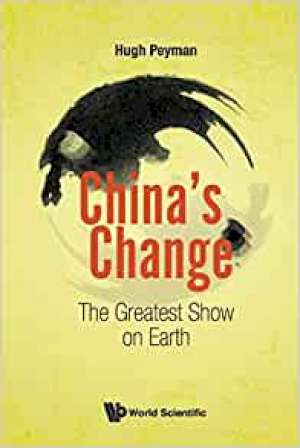23 July 2020
China's Change:
The Greatest Show on Earth
Hugh Peyman
2018, World Scientific, 367 pages,
ISBN 9789813231993
Reviewer: Ian Harwood

As the Chinese economy has become an ever larger and more integral part of the global economy, so too has China-watching become an increasingly active pursuit. Now the world’s second largest economy and its most populous, China is experiencing the most extensive industrialisation, urbanisation and construction project in history, and no end seems in sight. As a consequence, its GDP growth continues to outpace by far that of more developed economies and its appetite for imports – be they commodities manufactures or, increasingly, services – remains ravenous.
As interest in the Chinese development phenomenon has surged, authors and publishers have responded. And booksellers’ shelves now groan under the weight of tomes about China, with no indication that readers’ appetite is yet sated.
Amidst this flow of books, however, a distinctively pessimistic genre flourishes. Beginning with Victor Chan’s “The Coming Collapse of China”, first published in 1992, there has been a continual stream of pessimistically-inclined books which argue that China’s fast-expanding economy is about to hit the buffers, whether as a result of over-investment, a property implosion, a corporate debt blow-up or a banking system collapse. Significantly, no let-up in such a relentlessly downbeat narrative – mirrored by so much media commentary – is discernible. And this constitutes, of course, a crystal-clear illustration of the old adage that “bad news sells”.
Importantly, China’s Change: The Greatest Show on Earth provides a welcome contrast to such fashionable pessimism. Indeed, the author Hugh Peyman clearly believes that China will continue to go from strength to strength. It’s well worth reading, moreover, why he thinks so.
Peyman certainly has impeccable China-watching credentials. He moved out to Hong Kong in 1977 as a Reuters reporter, subsequently worked for the (sadly now defunct) Far Eastern Economic Review and then moved into the world of investment research. Once arrived, moreover, he never left the region and has lived in Asia – most recently in Shanghai since 2002 – for over four decades.
Peyman’s underlying thesis is that the extraordinary development of China’s economy since its dog days in the immediate aftermath of the crippling Cultural Revolution of 1966-76 can only be properly understood through the lens of the country’s lengthy recorded history and, in particular, in terms of the evolution of its distinctively Confucian culture and the adaptive, problem-solving “managing change” mind-set to which this has given rise. This, to my mind, is a wholly original approach to understanding present-day China and the book is well worth reading for this alone.
Peyman devotes the reminder of his book to how this has played out in practise – and a very convincing case he makes too. Laced with anecdote and example, Peyman’s discourse is always instructive and readers are likely to end up considerably wiser about how the Chinese economy has developed and how it currently works. En route, moreover, Peyman convincingly demolishes a series of popular urban myths such as those of a satiated property market and the continued dominance of the state-owned sector. He also usefully demonstrates how China has continually sought to learn from other countries’ successes and, also, mistakes.
It’s difficult to do justice to the exceptionally wide-ranging scope of the book. It is, furthermore, well-written (as befits a former journalist) and highly readable. If it has a fault, it is that of an overweening optimism about China’s future which seems unalloyed by any misgivings at all on the author’s part. But that flaw, to be fair, is understandable in the light of the extraordinarily successful progress which has been made in raising Chinese living standards ever since the “regime change” which began in 1978, a spectacle to which Peyman has borne witness throughout the course of his Asia-based career. Such an upbeat reading of what the future holds for the world’s most populous nation, moreover, serves as a useful corrective for the innate pessimism which has pervaded so much Western economic and financial commentary in recent years.
